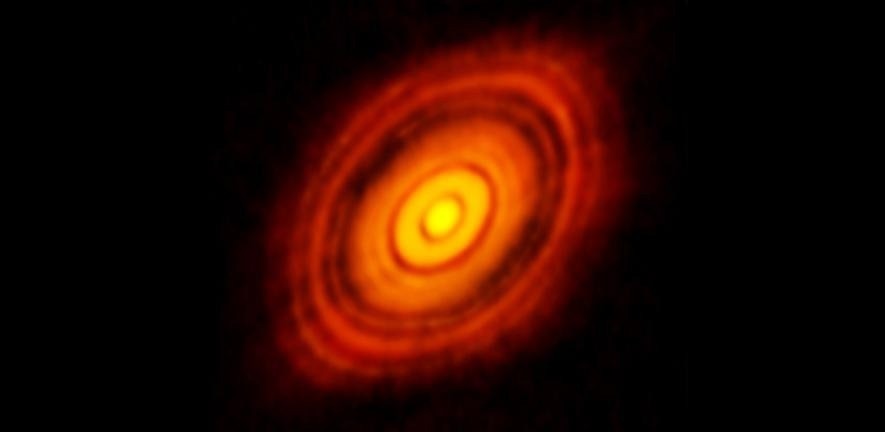Little “hurricanes” that occur in gas and dust discs around newborn stars can be utilized to study specific aspects of planet formation, even for smaller planets that orbit their star at great distances and are out of reach for most observatories.

ALMA image of the protoplanetary disc around HL Tauri. Image Credit: ALMA (ESO/NAOJ/NRAO)
The University of Cambridge and the Institute for Advanced Study created a strategy that combines measurements of these “hurricanes” by the Atacama Large Millimeter/submillimeter Array (ALMA) to constrain the mass and age of planets in a young star system.
Planet formation begins in pancake-like clouds of gases, dust, and ice encircling young stars, called protoplanetary discs. Gravity drives particles in the disc to stay together in a process known as core accretion, eventually producing larger solid bodies like asteroids or planets. Young planets begin to cut gaps in the protoplanetary disc, much like grooves on a vinyl record.
According to current calculations, even a small planet—as small as one-tenth the mass of Jupiter—may be capable of causing such gaps. Because these “super-Neptune” planets can orbit their star at a greater distance than Pluto orbits the Sun, established methods of exoplanet discovery are ineffective.
Besides the grooves, ALMA scans have revealed additional distinguishing structures in protoplanetary discs, like banana- or peanut-shaped arcs and clusters. It was previously assumed that at least some of these structures were also propelled by planets.
Something must be causing these structures to form. One of the possible mechanisms for producing these structures—and certainly the most intriguing one—is that dust particles that we see as arcs and clumps are concentrated in the centers of fluid vortices: essentially little hurricanes that can be triggered by a particular instability at the edges of the gaps carved in protoplanetary discs by planets.
Roman Rafikov, Study Lead Author and Professor, Department of Applied Mathematics and Theoretical Physics, University of Cambridge
Roman Rafikov is also associated with the Institute for Advanced Study in Princeton, New Jersey.
Rafikov used this interpretation, along with his Ph.D. student Nicolas Cimerman, to create a technique for constraining a planet’s mass or age if a vortex is discovered in a protoplanetary disc. Their findings have been approved for publication in two independent papers in the Monthly Notices of the Royal Astronomical Society.
It’s extremely difficult to study smaller planets that are far away from their star by directly imaging them: it would be like trying to spot a firefly in front of a lighthouse. We need other, different methods to learn about these planets.
Roman Rafikov, Study Lead Author and Professor, Department of Applied Mathematics and Theoretical Physics, University of Cambridge
To devise their method, the two scientists first calculated theoretically how long it would take for a planet to generate a vortex in the disc. These calculations were then used to constrain the parameters of planets in discs with vortices, thus establishing lower limits on the planet’s mass or age. These approaches are known as “vortex weighing” and “vortex dating” of planets.
When a growing planet reaches large enough, it begins to push material from the disc away, resulting in a recognizable gap in the disc. When this occurs, the material on the outside of the gap becomes denser than the stuff on the inside. As the gap widens and the density differences increase, instability can occur. This instability disturbs the disc and can finally result in the formation of a vortex.
Cimerman adds, “Over time, multiple vortices can merge together, evolving into one big structure that looks like the arcs we’ve observed with ALMA.”
As vortices require time to form, the researchers describe their method as a clock that can aid in determining the mass and age of the planet.
More massive planets produce vortices earlier in their development due to their stronger gravity, so we can use the vortices to place some constraints on the mass of the planet, even if we can’t see the planet directly.
Roman Rafikov, Study Lead Author and Professor, Department of Applied Mathematics and Theoretical Physics, University of Cambridge
Astronomers can estimate the age of a star using multiple data points like spectra, luminosity, and motion. Using this data, the Cambridge researchers determined the smallest probable mass of a planet that might have been in orbit around the star since the protoplanetary disc developed and produced a vortex visible to ALMA. This allowed them to place a lower limit on the planet’s mass without directly viewing it.
Using this technique on several known protoplanetary discs with significant arcs suggestive of vortices, the scientists discovered that the putative planets causing these vortices must have masses in the super-Neptune region, at least several tens of Earth masses.
“In my daily work, I often focus on the technical aspects of performing the simulations. It’s exciting when things come together and we can use our theoretical findings to learn something about real systems,” stated Cimerman.
“Our constraints can be combined with the limits provided by other methods to improve our understanding of planetary characteristics and planet formation pathways in these systems. By studying planet formation in other star systems, we may learn more about how our own Solar System evolved,” concludes Rafikov.
The study was funded in part by the Science and Technology Facilities Council (STFC), part of UK Research and Innovation (UKRI).
Journal Reference
Cimerman, N. P. & Rafikov, R. R. (2023) Emergence of vortices at the edges of planet-driven gaps in protoplanetary discs. Monthly Notices of the Royal Astronomical Society. doi.org/10.1093/mnras/stac3507.